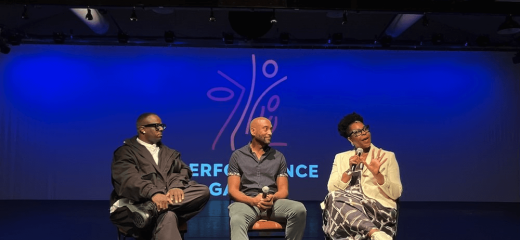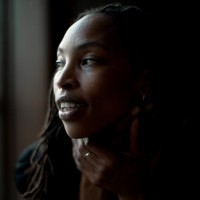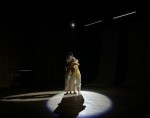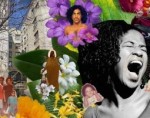
Talking About Blackness, Ballet, and a Hard Won Empowerment
by Shayla-Vie Jenkins
“Ballet culture and dance culture reflect culture at large so that the systematic racism and hierarchy that we’re fighting (in the world) is also reflected inside…and the reality is that for Black and Brown people the goalposts keep moving…That’s the game!” (Theresa Ruth Howard)
Performance Garage's most recent HubChats, When Yesterday Meets Tomorrow: Being Black in Ballet Today and Asking Questions, hosted an engaging conversation between its DanceVisions Resident Artist, Meredith Rainey, and Philadanco artist in residence Tommie-Waheed Evans. It began with a heartfelt moment of silence in honor of the late pioneering Black ballet dancer and teacher Delores Browne. Browne's legacy underscores Philadelphia's significant role as a dance nexus, a city that continues to nurture incredible talent like Evans and Rainey.
Theresa Ruth Howard moderated with exceptional knowing, humor, and ease. She asked provocative questions that allowed the conversation to go deep within just one hour. Howard is a native Philadelphian, actively involved in efforts to foster inclusion and equity within the field, including her online archive, Memoirs of Blacks in Ballet. All three artists highlight with great candor the unique challenges Black choreographers face navigating the predominantly white Eurocentric ballet world, cheekily referred to as a country club. The tone of the conversation, a far cry from victimization and complaint, directs our attention to their hard-won empowerment.
As a Black dancer whose background is primarily in modern dance, my familiarity with conversations about race in ballet has been through the stories of its prominent dancers including Janet Collins, Raven Wilkinson, Arthur Mitchell, Virginia Johnson, Aesha Ash, Misty Copeland, Taylor Stanley, and Calvin Royal. Both Rainey and Evans share similar experiences but with nuanced differences. They argue that one of the greatest hurdles for Black dancers and choreographers is gaining access, breaking through gatekeeping barriers. How does one get a foot in the door without having the same pedigree, privilege, or networks as their white counterparts? And once you do gain access, the rules seem to keep shifting.
Rainey, a former member of the Pennsylvania Ballet (rebranded as the Philadelphia Ballet in 2021), reflected on the challenges of leaving the company as a celebrated dancer and then re-entering as a choreographer. He says he has reached a point where he feels liberated from the pressure to create work that fits certain expectations of a Black choreographer. “I am going to be the artist I need to be and not the artist they need me to be.”
Evans, a freelance choreographer with Lulu Washington and Philadanco lineage, positions himself outside the traditional ballet establishment. Evans says he has learned to operate in any space with a mature sensitivity while not compromising his authentic self or artistic goals. He adds that he has become less rigid and prescriptive, creating practices with multiple entry points to convey his ideas. He doesn't want to teach others about his Blackness. He wants it to be evident through his work without the need for explanation or validation.
Howard drives home the point that Blackness complicates; it can never be separated from the person or their work. She doubts that non-Black choreographers feel the same trepidation when entering the ballet studio; there is a unique flavor to what Black artists wrestle with. “The head game that we have to learn to play with ourselves is to just be enough in our own artistry.”
One thought-provoking exercise introduced by Howard was the idea of "Flipping it to Test." She prompts Rainey and Evans to consider whether they would accept a project choreographing an East Indian love story if offered, or pass it on to a colleague better suited for the task. Evans pushes back, stating that such opportunities rarely come their way, and if they are invited to create for a project like that then there is already an expectation to disrupt. Howard emphasizes the futurity of the exercise–that we might one day be in these positions and that it's not a question of right and wrong, but to consider saying no as an act of allyship. This back and forth held some excitable tension which transitioned into a short question-and-answer session that ended all too quickly.
During the audience Q&A, a young Black collegiate dancer asked how capitalistic and consumer cultures affect their work, while another pondered how choreographers can ease the burdens for the next generation. Another mentioned the disparaging research that Blacks only make up 4% of artists in ballet. However, I would argue that it's essential to recognize that percentages alone don't fully convey the progress being made. Black artists–including Kyle Abraham, Sidra Bell, Jamar Roberts, Christopher Rudd, Jennifer Archibald, Claudia Schreier, Amy Hall Garner, Micaela Taylor–choreograph for major ballet companies; Blacks in Ballet, an Instagram hub created by Afro-Brazilian dancers Ingrid DaSilva and Fabio Mariano, showcases Black ballet artists across the globe; Courtney Taylor Key’s Negus Ballerina Project offers educational support and fellowship to Black ballerinas. Many U.S. ballet companies have introduced diversity statements, with San Francisco Ballet even making its diversity reports accessible online.
I see a positive step toward increased representation and accountability. There is a growing presence of BIPOC artists at various levels within these organizations, offering hope for a more inclusive future. This Hubchats discussion is also a testament to that progress. Reflecting on my own experiences as a young aspiring dancer at the Princeton Ballet School, where I often felt like an outlier, I'm encouraged by the progress being made. As I left the event, I felt a renewed excitement to explore and appreciate more of the strides Black artists have made in ballet.
By Shayla-Vie Jenkins
October 10, 2023








